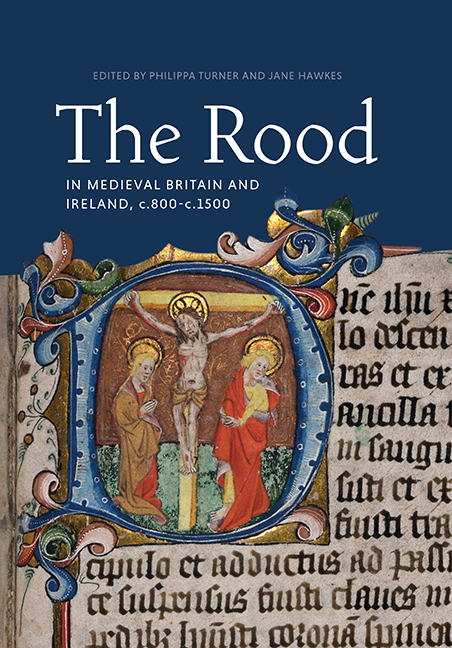Book contents
- Frontmatter
- Contents
- List of Illustrations
- List of Contributors
- Acknowledgements
- List of Abbreviations
- 1 Introduction: Rethinking the Rood
- 2 Approaching the Cross: The Sculpted High Crosses of Anglo-Saxon England
- 3 The Mark of Christ in Wood, Grass and Field: Open-Air Roods in Old English Medical Remedies
- 4 Twelfth-Century English Rood Visions: Some Iconographic Notes
- 5 Crosses, Croziers and the Crucifixion: Twelfth-Century Crosses in Ireland
- 6 From Religious Artefacts to Symbols of Identity: The Role of Stone Crosses in Galician National Discourse
- 7 The Rood in the Late Medieval English Cathedral: The Black Rood of Scotland Reassessed
- 8 The Cross of Death and the Tree of Life: Franciscan Ideologies in Late Medieval Ireland
- 9 Heralding the Rood: Colour Convention and Material Hierarchies on Late Medieval English Rood Screens
- 10 Reframing the Rood: Fifteenth-Century Angel Roofs and the Rood in East Anglia
- Bibliography
- Index
- Already Published
- Plate Section
1 - Introduction: Rethinking the Rood
Published online by Cambridge University Press: 07 November 2020
- Frontmatter
- Contents
- List of Illustrations
- List of Contributors
- Acknowledgements
- List of Abbreviations
- 1 Introduction: Rethinking the Rood
- 2 Approaching the Cross: The Sculpted High Crosses of Anglo-Saxon England
- 3 The Mark of Christ in Wood, Grass and Field: Open-Air Roods in Old English Medical Remedies
- 4 Twelfth-Century English Rood Visions: Some Iconographic Notes
- 5 Crosses, Croziers and the Crucifixion: Twelfth-Century Crosses in Ireland
- 6 From Religious Artefacts to Symbols of Identity: The Role of Stone Crosses in Galician National Discourse
- 7 The Rood in the Late Medieval English Cathedral: The Black Rood of Scotland Reassessed
- 8 The Cross of Death and the Tree of Life: Franciscan Ideologies in Late Medieval Ireland
- 9 Heralding the Rood: Colour Convention and Material Hierarchies on Late Medieval English Rood Screens
- 10 Reframing the Rood: Fifteenth-Century Angel Roofs and the Rood in East Anglia
- Bibliography
- Index
- Already Published
- Plate Section
Summary
The cross was central to medieval Christianity, both as an image and a material reality. In Britain and Ireland between c. 800 and c. 1500 it appeared as an image in wood, stone, paint, textiles, ivory and metalwork, within interiors and within the landscape, and it varied in scale from hand-held to monumental. The image could be ephemeral – the sign of the cross traced across the body – and it could also be conjured in the mind's eye, through prayer and poetry, and appear in visions. The cross in word and image, as object and part of speech, could both be present and mutually enhance one another, as suggested by Cambridge, Trinity College MS B.16.3, a c. 930 copy of De laudibus sanctae crucis by the Carolingian Hrabanus Maurus (d. 856), with its pages of intricate grids of poetry incorporating, variously, the figure of Christ (Fig. 1.1), cross-shapes, angelic figures, and the beasts of the Gospels; the Ruthwell Cross (Fig. 1.2), the eighth-century monumental cross with carved panels and inscribed with verses found also in the tenth-century poem The Dream of the Rood, presents us with a similarly complex mixture of the visual and the textual.
As well as centrality and complexity, the cross in Britain and Ireland (just as elsewhere in medieval Europe) can also be characterised by variety (in iconography, medium and location), and it is with acknowledgement of these broad characteristics that this volume builds on previous studies of the cross to understand further, but certainly without claiming any definitiveness, some of the kinds of meanings and functions it possessed within Britain and Ireland c. 800–c. 1500. The chapters collected here also have a wider aim, that of deepening our understanding of the visual and material culture of medieval Christian worship within these geographical and chronological boundaries. It is worth briefly outlining in broad strokes the shape of previous scholarship in order to better contextualise the chapters within this volume.
The image of the cross could be a crucifix, a cross bearing the figure of Christ in the act of sacrificing himself for the salvation of the world, or aniconic, four arms of an object only; yet it is also worth remembering, as Sarah Keefer has pointed out, ‘the image of the cruciform presents its viewers with the rudimentary shape of a human being… the frame without flesh’.
- Type
- Chapter
- Information
- Publisher: Boydell & BrewerPrint publication year: 2020

